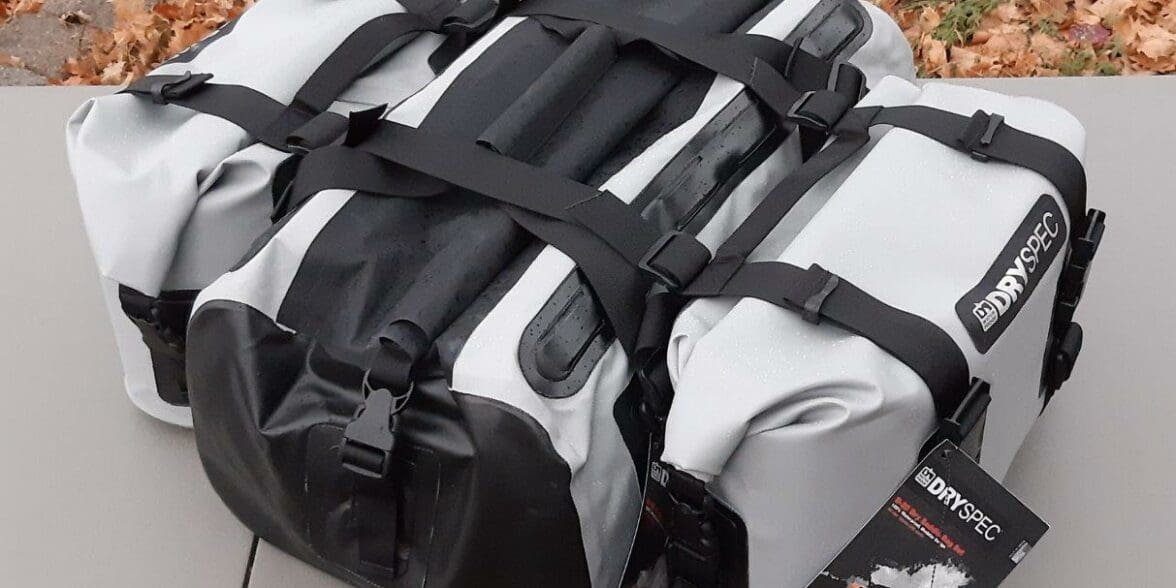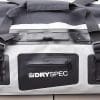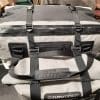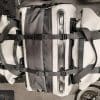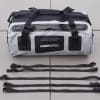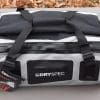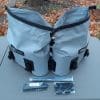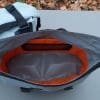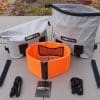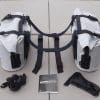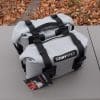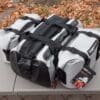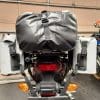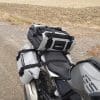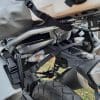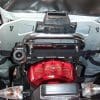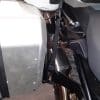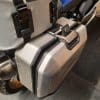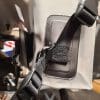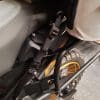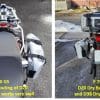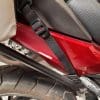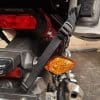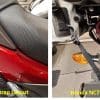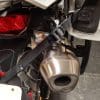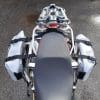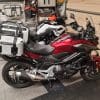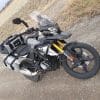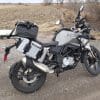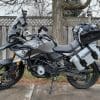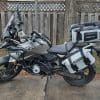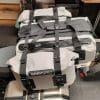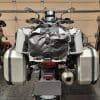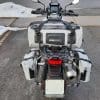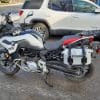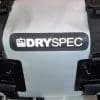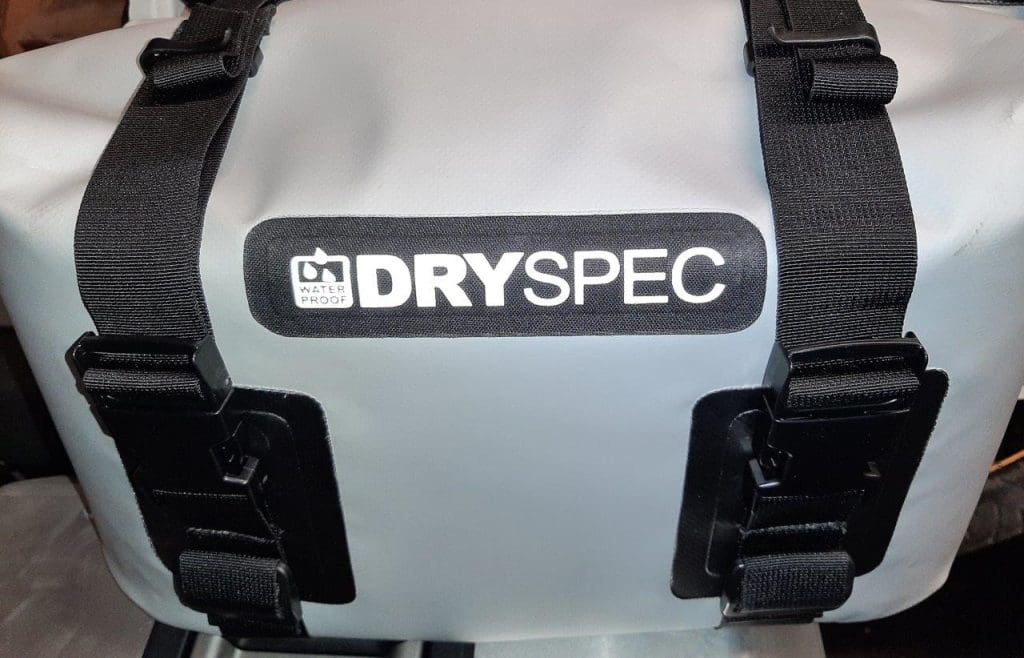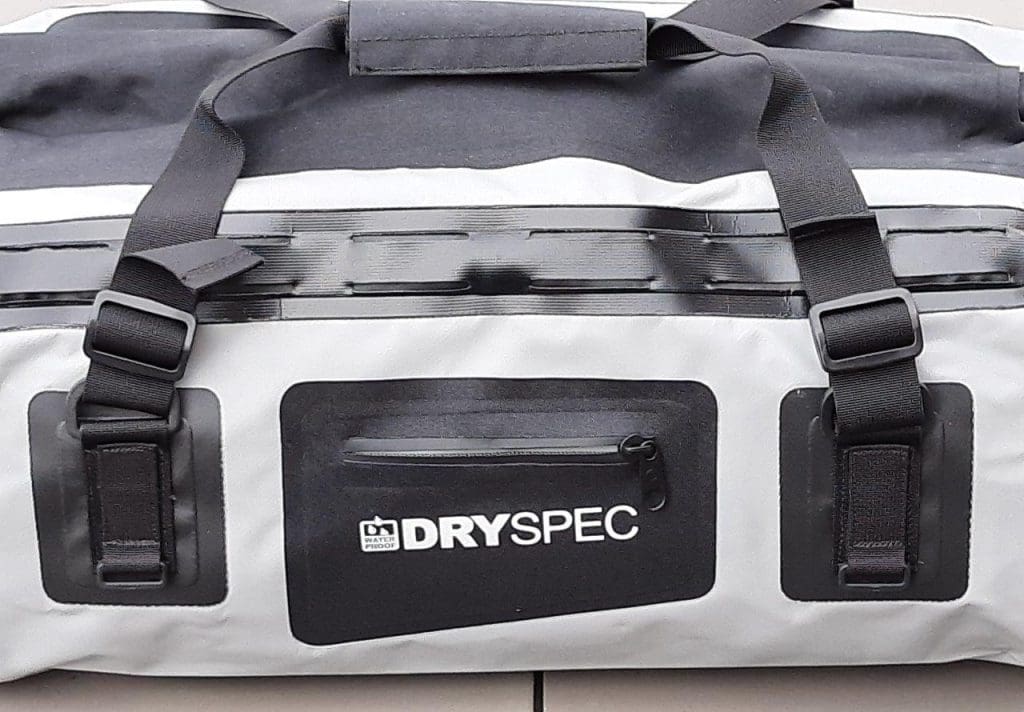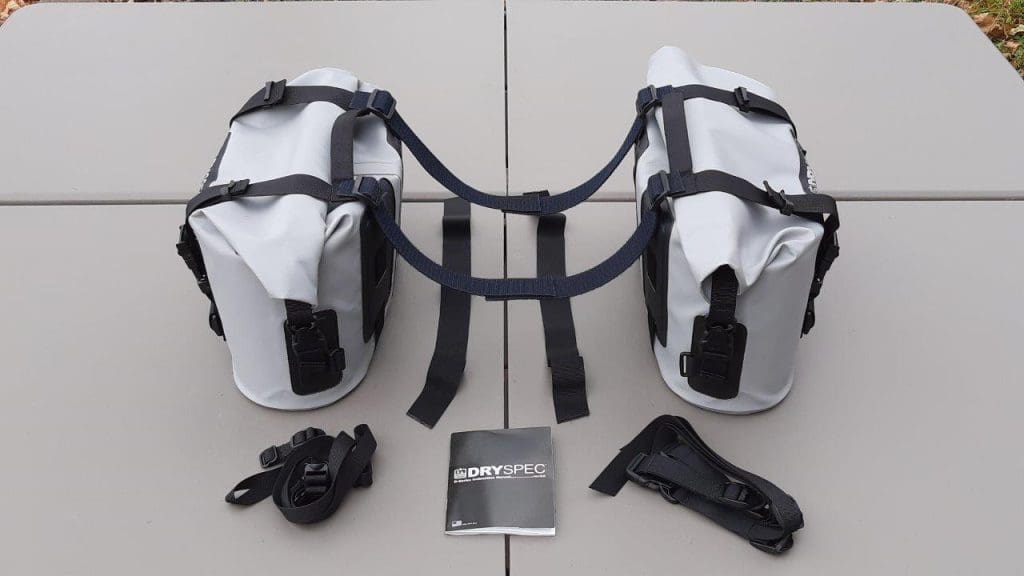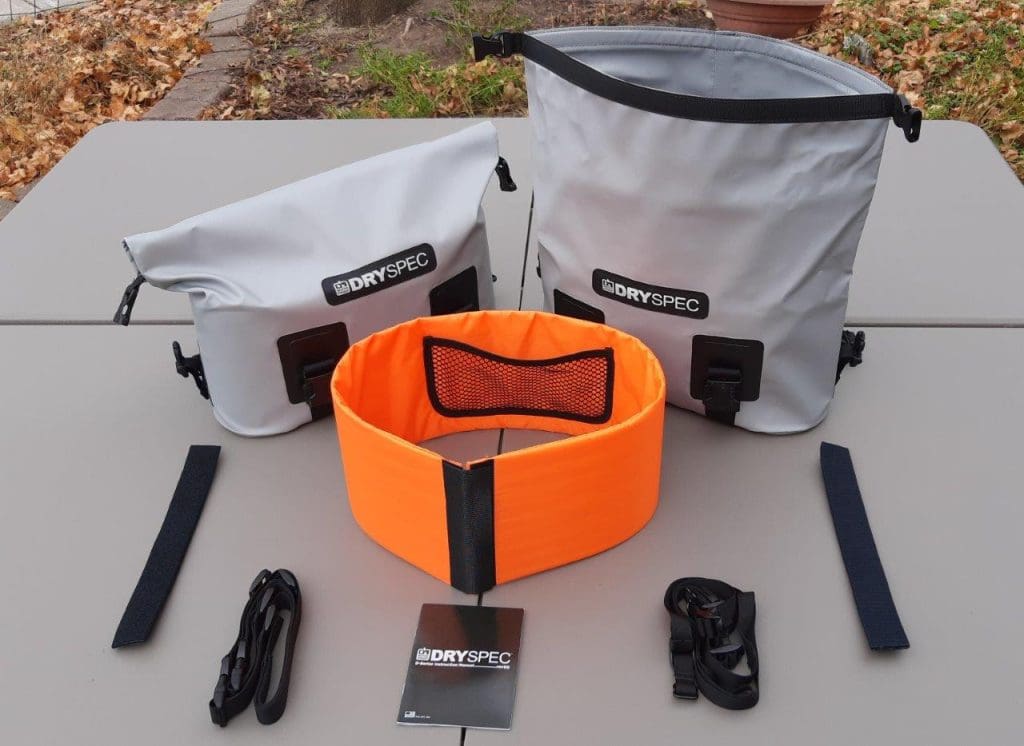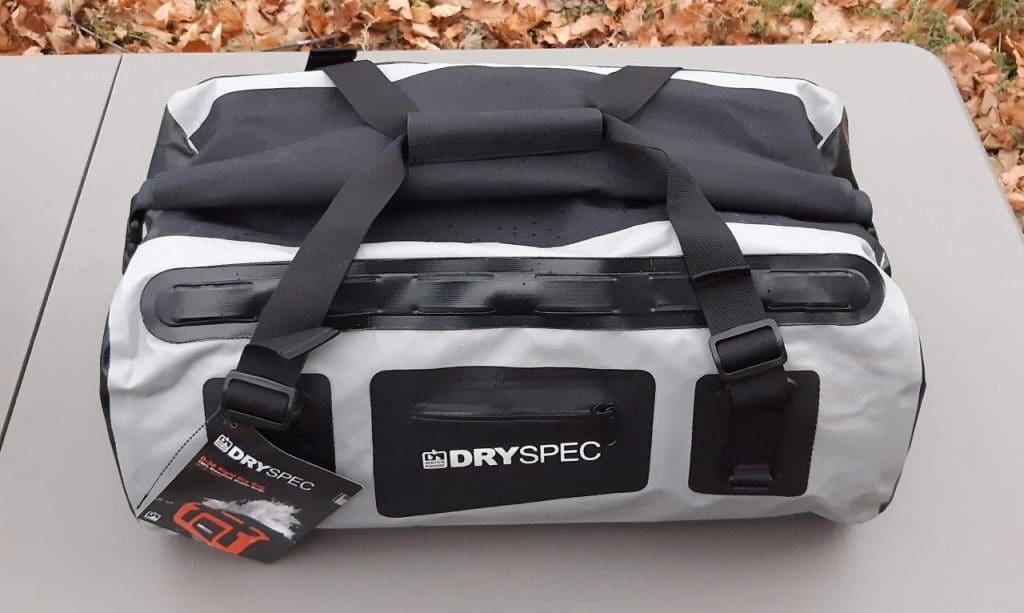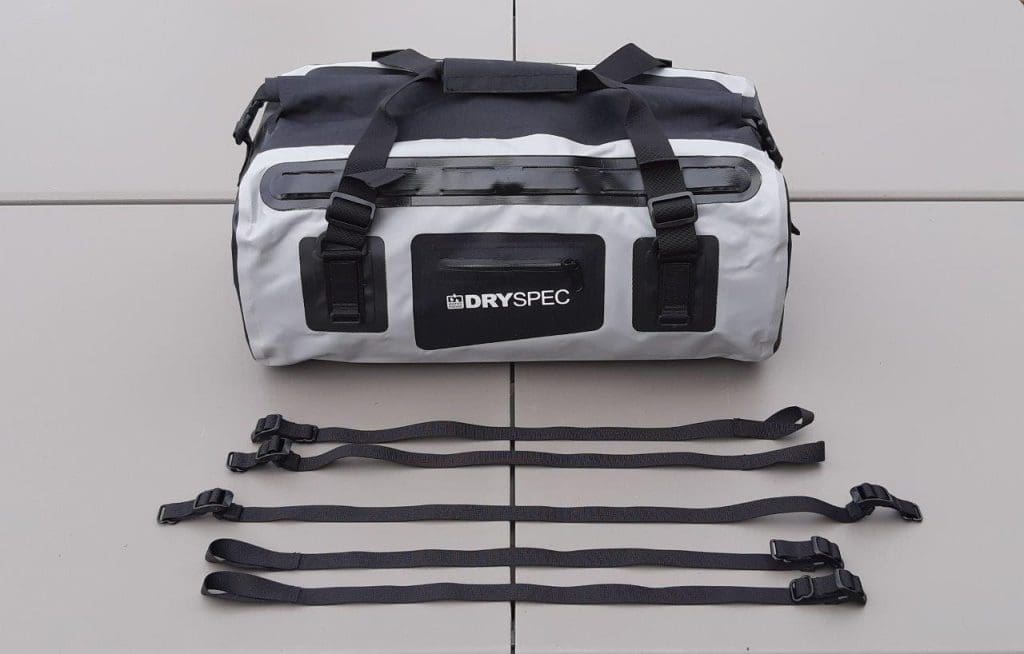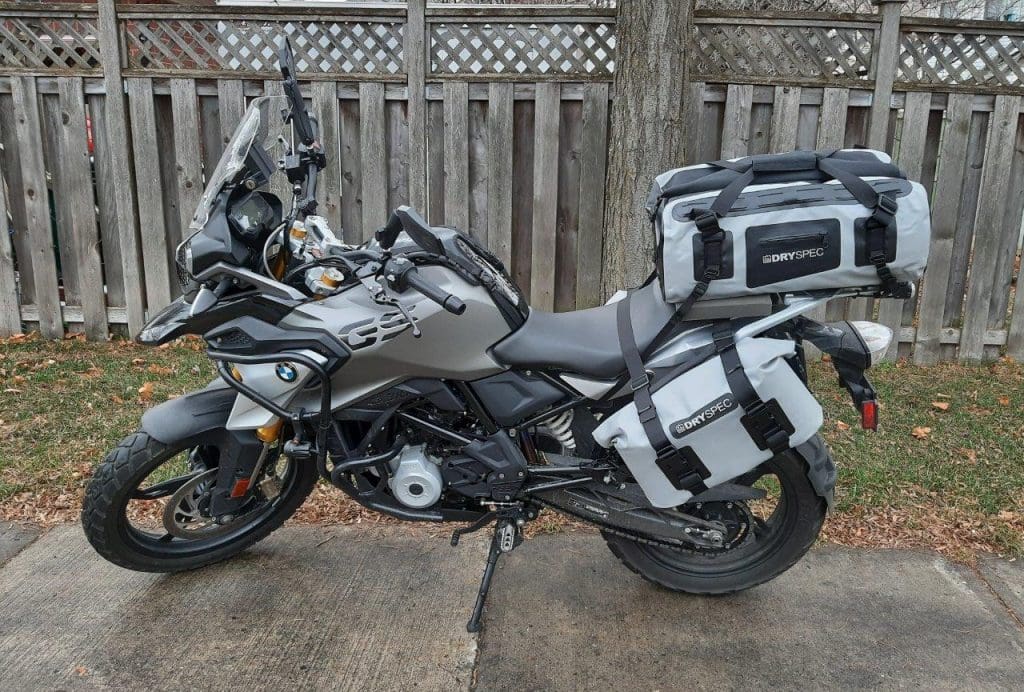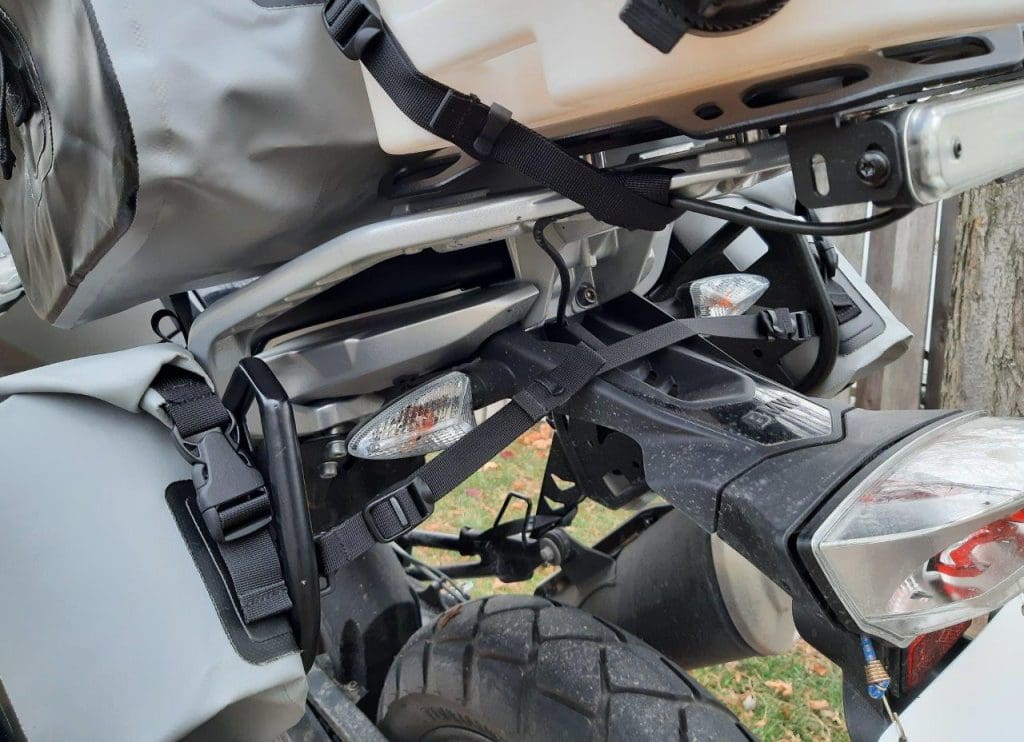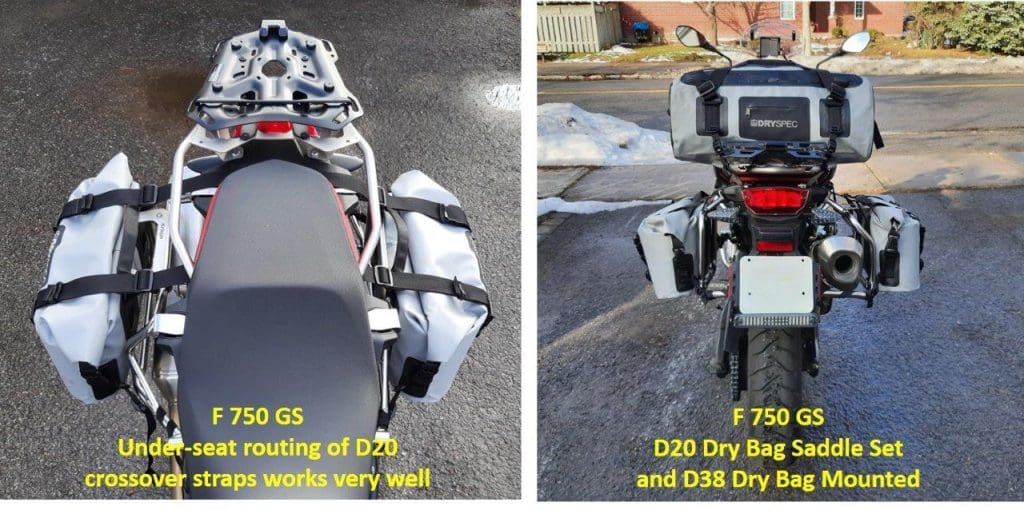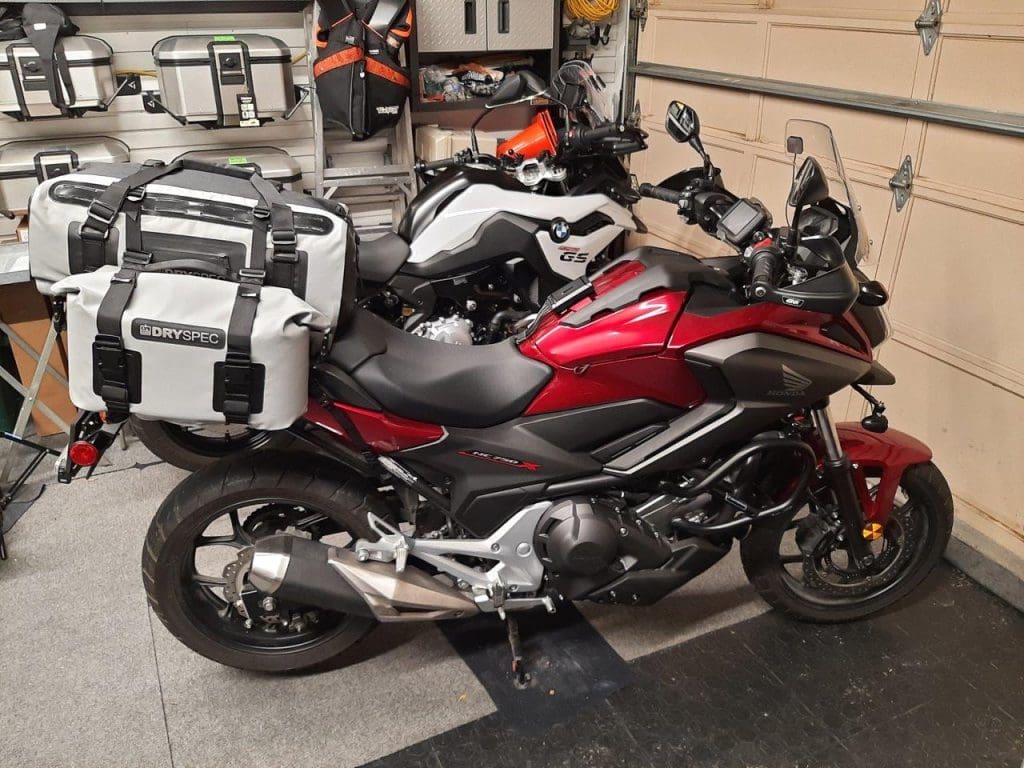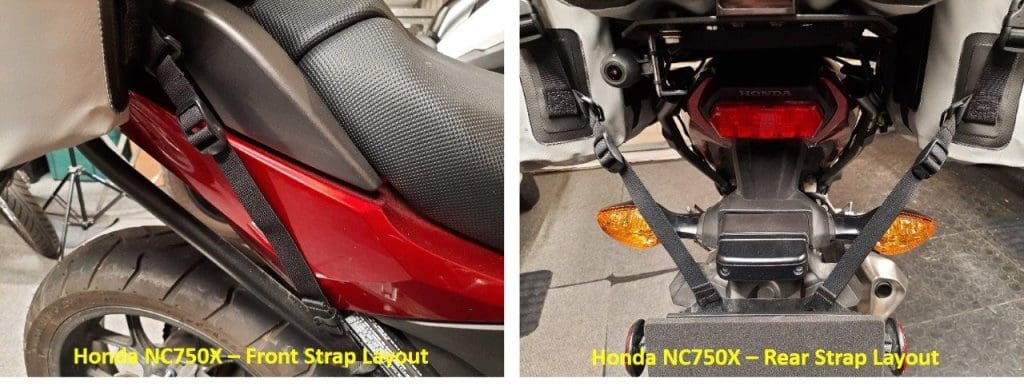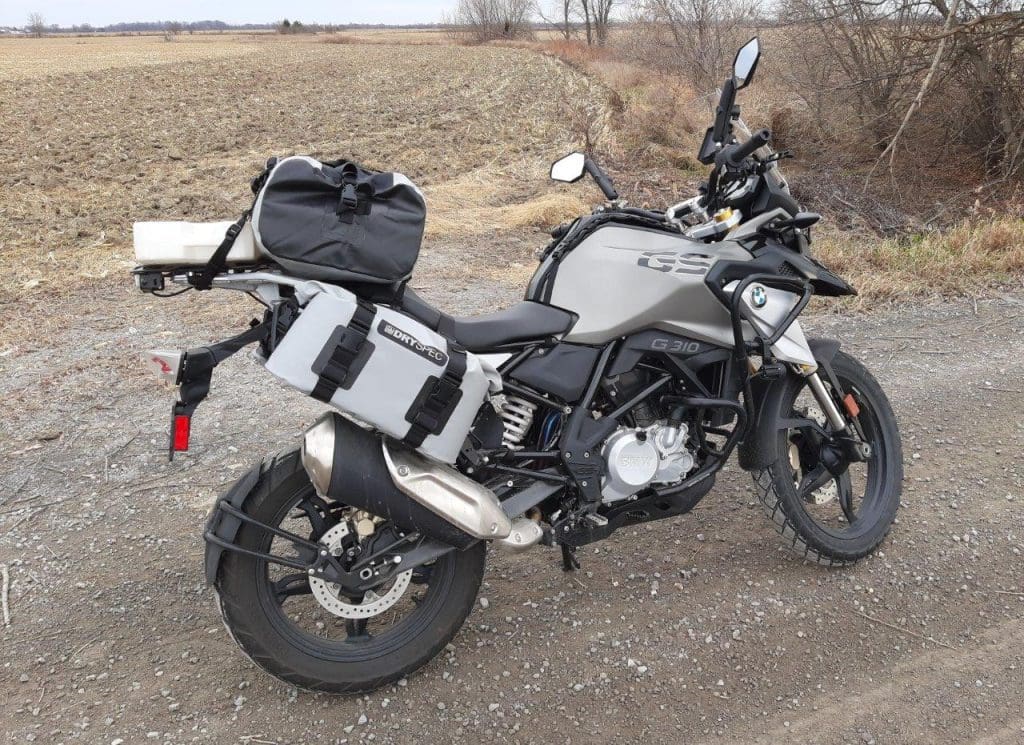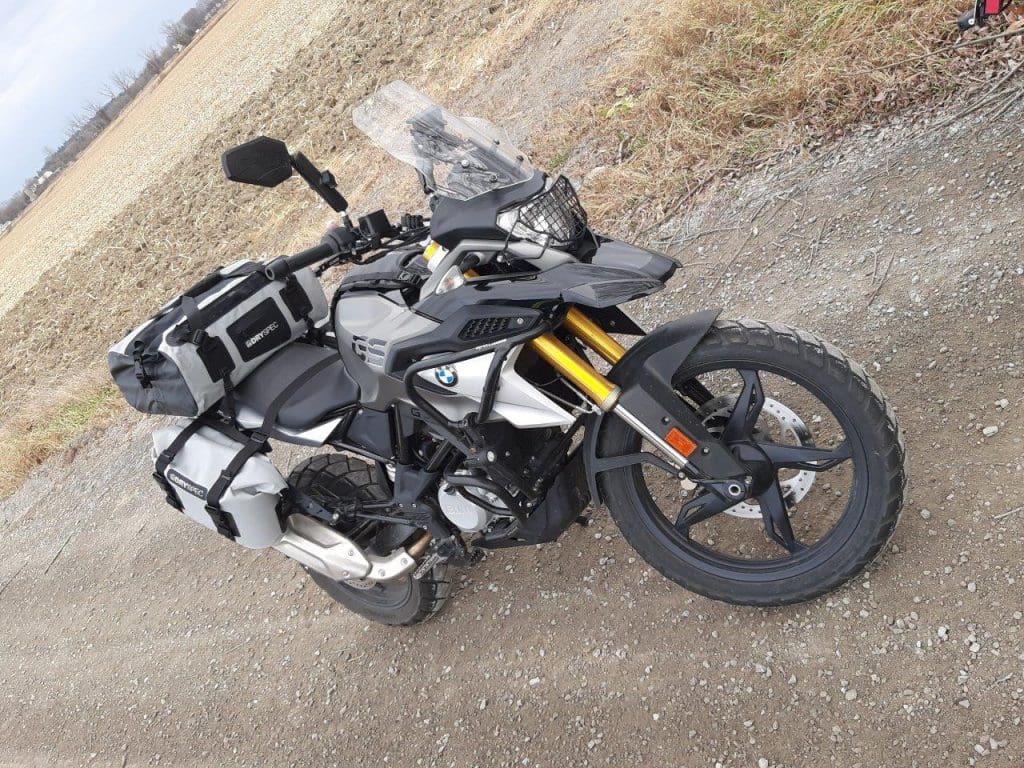Introduction
Our COVID-19 world has, for many, put a major crimp in travel activities, including those motorcycle-based; but what helps to remain positive and looking ahead is that we can still plan for the road ahead. And part of this planning usually involves a packing list and along with the packing list, the manner of holding and securing the packed contents or load list.
In travelling, one usually learns, at some point in time, not to put “all the eggs in one basket” so to speak and at this one point in time, a single packed bag, with everything needed in it, will indeed be lost or damaged. My comment is, “experienced that, learned from it”.
And in having learned the lesson above early on in my travels, adopting a multiple piece packing strategy has never been regretted and while there was lots of functional luggage for other types of travels, there wasn’t much specifically for motorcycling, other than using small personal luggage pieces or trekking/climbing gear – pieces that worked but had limitations.
Thankfully, between having some good military designed gear, typically soft-sided, sometimes waterproof but very rugged and, diving gear bags that were waterproof and this mix of luggage gear kept personal and travel stuff secured and relatively protected, including dry.
Zooming ahead to present day, we are now indeed spoiled by the plethora of hard, semi-rigid or soft-sided luggage available for packing and/or carrying our gear. And without stirring up the pot regarding which form factor is best, it is sufficient to say that they all have strengths, weaknesses and for the most part, luggage truly remains a personal choice.
Over the years, no one form factor has emerged as the only or go-to solution for motorcycle use luggage and any specific layout is typically driven by the type of travel and to a lesser degree, duration. As such a combination of semi-rigid or soft-sided luggage and a small lockable top box (if hard side cases are not used) works.
But admittedly, based on riding experiences and travel habits there is also the desire (need) to have as much portability and flexibility as possible regarding packing and this keeps me leaning towards semi-rigid or soft-sided solutions as the primary or larger luggage pieces, especially when some of them make good personal or backpack luggage pieces.
Products like the Wolfman Rocky Mountain Expedition Saddle Bags or the Mosko Moto Reckless 80 system, among many (many) other products, are two good examples using the soft-side and semi-rigid approach, with the ability to carry a lot of packed gear in two saddle bags or as divided between multiple but compatible roll-end pieces.
Both these products utilize a dry bag approach, a design that provides a totally sealed and 100% waterproof environment when used properly, along with a light weight and portability; features important for outdoor use, including powersports and motorcycling specifically.
Original dry bag solutions, whether with minimal form or semi-rigid with some form of internal or external frame or support were designed and constructed for individual piece use, like the 120 Litre drybag originally designed for diving activities but then adapted for backpacking or powersports use – when loaded it is a bit much for trekking but perfect for motorcycle use.
And another issue early on was that if a user wanted to strap multiple pieces together (remember the comment made earlier?), it was up to the user to find or create a functional and safe solution from multiple pieces – a form of modularity, but without much standardization or commonality and, often not effective overall. And in retrospect, often not very safe either…
Things have evolved…readers only need to do a search or look through the wBW archives to realize how positively and (relatively) quickly the situation changed; it is now rare to find a dry bag that cannot serve as part of a modular luggage system allowing us to pack and carry as little or as much (skip the kitchen sink) as needed – conveniently, securely, and of course, safely.
As a long-time advocate for and user of soft or semi-rigid dry bag gear, the interest in seeing and using new stuff never goes away…one reason why so many dry bags of all designs, shapes and sizes have passed through, or remained, over the years.
And this brings us to the products used for this review, the D78 Modular Packing System, a combination comprised of the D20 Dry Bag Saddle Set and a D38 Rigid-Core Dry Bag from the Twisted Throttle DrySpec D-Series line of drybags.
DrySpec and the D-Series Dry Bags
Founded in 2010, DRYSPEC is part of the Twisted Throttle group that also includes Denali Electronics. DrySpec came into being due to long term frustration over the lack of good 100% waterproof drybag gear focused on motorcycling use but with the versatility to be used for almost anything else.
In working towards the objective of making highly versatile waterproof and easy to use gear, features like modularity, rigid core construct, integrated mounting straps and encompassing interconnectivity became common (and valued) attributes of the expanded product line.
DrySpec brand is now a major supplier of high quality waterproof drybag and hard case products for the outdoors – no matter the activity, no matter the platform.
A number of ‘Collections’ or focus areas are listed for the DrySpec product line: Base Dry Bags, Camp, Combo Dry Bags, D-Series Dry Bags, H35 (Hard) Luggage System, Marine, Moto, Small Storage, Snow, and Straps & Accessories. This review focuses on the D-Series Dry Bags.
DrySpec D78 Modular Packing System
One of the best (of many) dry bag combinations provided by the DrySpec D-Series dry bags is the D78 Modular Packing System, the combination provided for this review by Twisted Throttle.
It is comprised of the D38 dry bag as the larger centre or core piece and either used on the motorcycle with a set of D20 dry bag saddle bags or with the individual D20 dry bags attached to the D38 to form a single large combination.
If more capacity is needed, adding equal or larger capacity dry bags is done expediently, with another popular combination that approaches or exceeds the capacity provided by many hard side case and top box combinations being the D106 Modular Packing System.
The D106 layout uses a D28 dry bag stacked and connected on top D38 dry bag with the individual D20 dry bags from the saddle bag set connected to each side of the D38 dry bag forming a four-piece modular packing system easily removed as a single carry piece.
Alternatively, the D-20 saddle bag set can be fitted separately to the motorcycle but interconnected to the D-38 and/or D-28 dry bags for security. And on it goes…versatility, flexibility and adaptability limited only by the dry bags, strapping, and imagination
First Impressions & Common D-Series Features
First impressions are important. And our first impressions of the D-Series modular packing system products, the DrySpec D-20 Dry Bag Saddle Set and the D-38 Dry Bag are all positive.
The pieces selected for this review were in Grey with black strapping and Modular Lightweight Load-carrying Equipment or MOLLE layouts. While not as conspicuous as the Orange option this tone is more defining or visual than black and the flat grey works well with so many common motorcycle paint schemes.
What really stands out are the common features between the two dry bag products – some are readily evident from their exteriors with more revealed once the dry bag roll-tops are opened; everything reflects common sense, experience, great design, build quality and, versatility.
The DrySpec dry bags look good whether on the bench or mounted on the motorcycle, empty or full; traits not always seen with soft side or hybrid luggage pieces. And this ‘looking good’ is due in large to their Rigid-Core liner that provides distinct shaping and form as well as padded security for contents.
And this padded rigidity makes packing, finding, and removing packed items much easier as well as the interior remains a shaped accessible space and the bag does not collapse or lose its basic shaping as contents are removed or adjusted, which is another benefit gained in that less ongoing adjustment or tensioning of straps is needed.
The roll-top design is another common feature between the D20 and D38 dry bags, although whereas the D20 dry bags have a full roll-top opening the D38 dry bag roll-top is gathered a bit and does not provide the same direct access to the interior as with the D20 dry bags.
When the roll-tops are in use, their end (F) buckles are attached to the adjustable (M) buckle sections found on the ends of the dry bags. These attachment point inserts are RF welded and the buckles are on short adjustable straps for pull-down tensioning and security.
Original objectives for the DrySpec dry bags were to make them (very) durable and (absolutely) waterproof; many early drybags were neither. And thanks to their 22oz vinyl construction with RF welded seams and coated Cordura panels the D-Series dry bags are both 100% waterproof, even when submerged or perhaps used as a flotation device and, proving to be (very) durable.
Last but certainly not least is their modularity so that individual drybags can be used together to form a system solution without compromising any one component while creating a safe manageable multi-piece packing solution.
Increasing capacity of this modular system is easy – use another D-series drybag of greater or lesser capacity and connect them together using the adjustable straps, integrated sliders and MOLLE layouts; outstanding flexibility and ongoing adaptability regarding use for any requirement or packing scenario.
The DRYSPEC D20 Dry Bag Saddle Set
Like all DrySpec dry bags, the D20 pieces use an internal rigid-core insert so the bags retain their shape even when empty, making packing and unpacking easy. The insert fits in around the perimeter of the dry bag and with the Velcro overlay strips secured together the dry bag has great semi-rigid form.
The individual inserts are quite stiff and very sturdy, but removable – separate the Velcro sections and work the insert out of the bag, made easier thanks to the full wide-mouth roll-top. If the inserts are removed the bags can be collapsed flat for storage or even packed with other luggage and taken along as spare pieces – more versatility.
The individual D20 dry bags measure 43.18cm x 15.24cm x 30.48cm (17 x 6 x 12in) based on Length x Width x Height layout. The capacity of each D20 dry bag is, you guessed it ~20 litres, for a set total of 40L, give or take depending on packing approach.
The full-length roll-top access really does simplify packing and accessing something quickly or in unpacking is easy, whether smaller individual stuff sacks are used to separate clothing or gear or if everything is just laid out (or stuffed) in the bag; everyone has their own method, although folding, rolling and layering items really does help in utilizing all available space…
A key part of the D20’s versatility is the interchangeable centre strap or cross-over options with both Velcro or nylon flat strap sets provided allowing the dry bag saddle set to be mounted to a motorcycle with or without side racks (see Installation Section below) or used separately with or without other D-series dry bags – you decide.
The included Velcro centre straps facilitate a quick hook-n-loop approach for standard over the seat layout placement but with a bit more profile and less flexibility of sorts, while the 38mm (1.5in) wide nylon flat straps are usable over the front or rear portion of the seat without being felt per se and provide more flexibility in routing, even under the seat.
And when not used the wide nylon flat straps can be safely stowed in the small outer side flat zippered pocket – that has a retro-reflective logo on its outside for side-view conspicuity (every little bit helps). The heavier duty Velcro cross straps are stowable inside the bags.
The D20 dry bag saddle set is available in Black, Orange, and Grey. An optional DrySpec Universal Exhaust Heat Shield for 4 to 6 in diameter mufflers is available and if there is any doubt regarding related clearances or heat, then fitting a shield is (highly) recommended.
Even motorcycles with a side frame kit of some sort can still require use of a heat shield depending on the placement of the exhaust/muffler components.
D20 Features & Specifications
- Modular component approach for direct fitment to D28 and D38 drybags
- Rigid-Core construction with removable padded interior shaping section
- 20L (5.28 USG or 0.7 cubic ft) per bag, total of 40L for the set
- Can be used with or without side racks
- Strap mounted carry handle on each dry bag
- Retro-reflective logo on outer pocket
- Available in Black, Orange, or Grey
- Formed of 22oz Vinyl and coated Cordura, 100% waterproof, RF welded seams
- Dimensions: 43.18cm (17in) Long x 15.24cm (6.0in) Wide x 30.48cm (12in) High
D20 Kit Components
- Set of D20 roll-top dry bags
- Four Velcro centre straps sections, hook & loop sided, each is 30.5cm or 12 in long
- Set of flat nylon centre straps, 54cm (21.25in) long, diagonal cut/trimmed
- Set of D78 combo straps, 81cm (31.8in), two-piece in-line quick release buckle connectors
- Set of slip-lock mounting straps, short, 37cm (14.5in) usable length, with frame loops
- Dual end slip-lock strap, long, 77.5cm (30.5in) usable length
The DrySpec D38 Rigid-Core Dry Bag
The DrySpec D38 piece uses a sturdy one-piece removable rigid-core insert that provides both a floor and sidewalls and is secured in place (not really needed) with three snaps per side.
This rigid-core insert is a great feature – strong and lightly padded and a stretch mesh pouch is positioned on one of the interior walls, opposite the outside zippered flat pocket (that also sports a retro-reflective logo).
The sidewalls of the insert extend up just slightly higher than the outer wall MOLLE inserts, forming a sturdy backdrop or support surface for when the MOLLE inserts are used, such as when connecting other D-Series dry bags.
Unlike the D20 dry bag inserts, however, the D38’s rigid-core insert is not easily removed due to the Cordura roll top section being gathered at what is the bottom of the roll-top, creating a less than full-sized opening. Access to the interior is still good, but not as easy as with the D20.
This Cordura insert is lighter and more pliable, but it seems out of place when the rest of the dry bag uses the heavier duty 22oz vinyl material. Getting rid of this insert material and providing a full roll-top opening would be great changes for any subsequent version…
The D38 dry bag measures ~56.5cm (22in) Long x 32cm (12.6in) Wide x 28cm (11in) High, with a capacity of, yep, 38 Litres, give or take depending on packing ability. The D38 Rigid-Core Dry Bag is available in Black, Orange and Grey.
For positioning and securing the D38 on the back of the seat or rack – across or lengthwise, the D38 dry bag has four adjustable slip-lock mounting straps with frame loop ends and a long dual-end slip-lock strap. Layout and mounting options are identified in the Installations Section.
D38 Features & Specifications
- Modular component approach for direct fitment/use with other D-Series dry bags
- Rigid-Core construction with removable padded interior shaping section
- 38L capacity (10 USG or 1.34cu ft)
- Removable flat-strap carry handle sections
- Retro-reflective logo on outer side pockets
- Available in Black, Orange, or Grey
- Formed of 22oz Vinyl & coated Cordura sections, 100% waterproof, RF welded seams
- Dimensions: 56.5cm (22in) Long x 32cm (12.6in) Wide x 28cm (11in) High
D38 Kit Components
- D38 dry bag
- Removable flat strap carry-handle (two pieces)
- Four slip-lock mounting straps, long, 61cm (24in) usable length, with frame loops
- Dual end slip-lock strap, long, 77.5cm (30.5in) usable length
- DRYSPEC D-Series Instruction Manual, rev00
DRYSPEC D78 Installation
The DrySpec D20 and D38 dry bag kits were laid out on multiple motorcycles for visual assessment and with a bit of adaptation, none of the motos are likely to be an issue regarding fitment of these products.
Four motorcycles (BMW G 310 GS, F 750 GS, F 850GSA, and a Honda NC750X) ended up hosting the kits for assessment and photos, with the G310GS and the Honda wearing the dry bag installations for road testing and use over varying periods of time; most of the narrative below is based on the G 310 GS installation.
The D20 and D38 dry bags, used separately or together, provide one of the best solutions going for a wide variety of motorcycles, no matter if small displacement machines used extensively for single track and trail use or, larger motorcycles that do a bit of everything.
Whether a first-time user or more experienced in mounting this type of luggage, it pays to read through or use the small (stowable) DRYSPEC D-Series Instruction Manual. This booklet covers the individual kits and the typical combination layouts with strap use clearly identified.
D20 Dry Bag Saddle Set
This kit doesn’t really need a side frame, depending on the motorcycle, but a side frame kit, even lightweight skeletal pieces are good in providing side support, needed clearances between luggage and motorcycle components, and providing strap points.
While the D20 dry bag saddle set can indeed be mounted higher up, taking advantage of the side of the seat and side-plastic panels for support and to maintain clearances, it’s not ideal for overall load placement, especially when side frame pieces are installed and available.
Numerous slots and cut-outs on the side frame plates allow the individual D20 bags to be fitted directly to the front down-angled side frames using the slider straps and MOLLE panels on the dry bags. But, as the overall objective is to keep the D20 set as a set and keep them easy to put on and take off, the over the seat solution is used as a starting point.
The D20 dry bags can sit lower against the Rally Raid side frames with the cross-over straps adjusted to provide a mounting angle to match the side frame orientation. But the Velcro straps end up being a bit short when run across the seat and are too heavy to be routed under the seat, so the 54cm or 21.25in flat nylon straps are used, although they are also too short.
But in taking a big roll of 3.8cm or 1.5in nylon flat strap from the storage bin, two longish straps, each 81cm or 31.8in in length, diagonally cut and heat sealed to provide the length needed, with some extra (seldom a bad thing). The diagonal cut helps run the straps through sliders or buckles and heat sealing keeps the ends from fraying easily.
These straps are laid out over the seat and although the front one sits across the back portion of the rider’s seat it is not noticeable. As expected, and as will be possible with many motorcycles the straps can be run under the seat and/or across the back of any tail section; just keep it all safe.
Once the D20 dry bags are positioned on each side to match the side frames, the short slip-lock mounting straps are brought into play to secure the front lower ends of each dry bag. Loop each strap through a (hopefully) convenient point – usually on the frame or passenger peg assembly, although the G 310 GS has well-positioned heel guards that work.
Now run the straps back to the lower front mounting points and with the slip-lock pieces laid flat push them through the 25mm or 1.0in (vertically) mounted plastic loops; the slip-lock pieces will not slide out once engaged on the opposite side of the loops.
Tighten the straps up with the sliders and use the plastic retainer to fold and tuck the excess out of the way. The retainers may or may not work very well, and if the excess works loose, wrap it around the strap and then use the retainer, or if the installation will have some permanency, use small zip ties or hook-n-loop wraps. Keeping strap pulls and ends securely minimizes slippage as well.
At the back, the long dual-end slip-lock strap is the bridging piece. Connect one of the slip-lock ends to one of the rear plastic loop points then route the strap across the back of the motorcycle, either across or under the tailpiece as used for the G 310 GS or, across and over the license plate frame mounting point; either of these options usually works well.
The objective for the back strap is to pull the bags back and down until there is even tension and the pieces are secure; don’t be afraid to spend some time trying different approaches; it’s all part of the learning experience.
D38 Rigid-Core Dry Bag
Whether used by itself or as part of the D78 Modular Packing System with the D20 saddle bag set, this larger back of seat or rear rack-oriented piece should be even less effort than getting the D20 pieces mounted and secured.
Place the D38 over or across the seat, back rack or both as is best to meet requirements or even just as a starting point. With the dry bag in the desired position and orientation, take the four (long) slip-lock mounting straps and find convenient loop or mounting points for the front and back.
Frame sections work for the front as do rear passenger peg or foot guard components and at the back using license plate frame layouts or tail section components can all work or if installed, a crossbar for any side frame accessory.
With the loop ends secured, run the straps up to the 1.0in plastic loops found on the lower ends of the main side strap assemblies, mount the slip-lock pieces through the loops and then use the slider to adjust each strap until the dry bag sits evenly and securely. Make sure any excess strap is wrapped or tucked away using the retainers.
On the BMW G 310 GS or the Honda NC750X, no matter whether the bag is positioned parallel or perpendicular on the seat and/or back rack, all four slip-lock straps are usable or with the two front straps in place, the single longer dual end slip-lock strap is used for the back as it bridges the distance across or around most parts.
D78 Modular Packing System – Sum of the Parts
When the D20 and D38 pieces are to be used as the D78 modular combination, then a bit of preparatory work is needed, unless the D20 dry bag saddle set is already installed, in which case the D38 need only be added. Either way, once the basic steps are understood, forming the combo is quick and easy – as intended.
When bringing the D20 saddle set and D38 bag together, the two-piece D78 combo straps, with their centred quick-release connectors, from the D20 kit are brought into play. Lay these two straps out over the top of the D38 and run the ends through the (second from the end) MOLLE pass-throughs on the D38 bag.
Run these ends down to and through the top bar of the (3-bar) slider on the top rear of each D20 compression strap, then back up to the tension or slide-lock buckles on the combo straps and route the ends of the straps through these buckles. This layout provides the means to both connect and adjust the height differential between the D38 and D20 pieces.
If the D20 set is already mounted and secured, some loosening of the lower front and back straps might be needed so that the D20/D38/D20 sandwich layout can be brought closer together to form a solid modular system.
With a bit of slack in the lower straps and with the D20 compression straps buckled, take their ends, and pull them up firmly which serves to tighten up (compress) the fit between the D20 dry bags and the centre D38 dry bag. Do this for both sides and then make sure the ends of the compression straps are (again) secured in their strap retainers.
The lower front and back mounting straps attached to the D20 dry bags can be tightened up fully to secure and tension the now formed modular packing system that is easily removed by detaching the lower mounting straps.
Once laid out and secured for the road, access to the interior of the D38 dry bag is still provided by using the (middle) quick release connectors that secure the two halves of each combo strap together and then releasing the roll-top end buckles so the roll top can be opened for interior access, all with minimal disruption of the modular packing system.
Other Installation Notes
The F 750 GS benefits from having the BMW Adventure Side Pannier frames installed along with a small adapter for the off-set layout on the right side needed when the Kriega OS-Adventure Kits are installed as mounting bases for larger soft luggage pieces like the Wolfman Rocky Mountain Expedition Saddle Bags WP evaluated earlier this year.
If there were no side frames installed, the D20 dry bag saddle set would be fitted higher to use the side of the seat and side plastic for support and both the Velcro or nylon cross-over straps would work. But with the D20 dry bags positioned to sit against the pannier frames the longer custom length nylon straps are needed.
After routing these front and rear cross-straps through the 3-bar slider on the top of the wide compression straps on one side they are run across (over or under) the seat and over the deck (front and rear respectively) and then through the 3-bar sliders on the opposing bag with needed height and angulation adjustments made as needed.
The lower front straps loop through the rear cut-out sections on the passenger peg assemblies while the long dual-end cross-over strap connects to the rear slip-lock mount on one D20 and is then wound around the cross-tube support for the BMW pannier kit over to the other bag and connected – it is just the right length (snug), so no tensioning with the sliders is needed.
As identified earlier, the small Kriega off-set adapter that sits on the upper frame tubing of the right pannier frame now comes into play, providing a support point for the upper edge of the D20 dry bag to sit against so it has a vertical layout to match the left side.
The Honda NC750X is the only motorcycle used that does not have some form of side frame kit installed making it a good candidate to further assess how well the D20 and D38 products work by themselves and when in the D78 combo – very well as it turns out.
The D20 dry bag saddle set goes on first with bags installed, using both the Velcro and nylon flat straps from the kit, laid out across rear portion of the seat and the back deck (front and back respectively) with the four slip-lock straps (two from each kit) used, although the single long dual-end slip-lock strap also works well for the back mounting.
With the D38 dry bag placed across the rear of the seat or back rack or perpendicular on the seat and rack, its four (long) slip-lock straps are used. The front straps go to the same trellis-frame point as used for the D20 straps (per the photos) with either two rear straps used as tethered to individual points on the license plate frame or the single long dual-end strap used.
To form the D78 Modular Packing System the D20 straps remain in place and the individual long mounting straps used for the D38 removed. Then the D38 interconnection steps described earlier using the D78 combo straps are completed and with all the straps checked for routing and tension, it’s done.
From a layout perspective, the D20 dry bags, with the combo straps adjusted for full layout are about 60% down the sides of the D38 dry bag with the lower part of the D20 bags resting against the side plastic and SW-Motech rear rack side rails.
This visual layout clearly reveals how much the side bags can be dropped down while still interconnected. Empty or loaded (with about 25kgs or 55lbs) of gear between the three bags a bit of back and side loading is felt but the combination is secure and the motorcycle stable. And no, the signal lights are not obscured at the rear by the straps…
On the tall, large-framed F 850 GSA, SHAD 4P and Topmaster kits for the TERRA aluminum cases provide lots of luggage options – hard case, soft-sided or some combination.
Migrating the DrySpec D78 combination from the Honda over to the F 850 GSA is simple – release the lower D20 straps and lift the complete combo away and then lay it out on the back of the GSA; that was (truly) easy.
And the only thing needing adjustment, done within a minute or two, is to move the D78 combo straps to the first and fourth (from the front) MOLLE pass-throughs, to reposition the D20 dry bags forward so they sit on the tops of the TERRA side cases – as envisioned, with no impact on access to the side-loaded TERRA case interiors.
There is more versatility to be made of these dry bags piece as well – if separated the individual D20 dry bags work great as auxiliary storage bags mounted on top of any side pannier cases or as was done with the F 850 GSA, mounting one on the lid of the TR37 top case using its four corner mounts.
Function & Performance Observations
Functionally, outside of some strap component observations made earlier and summarized below and the roll-top nit for the D38 dry bag, also identified earlier, the DrySpec D20 Dry Bag Saddle Set and D38 Rigid-Core Dry Bag, as separates or in the D78 Modular Packing System configuration deliver (period).
Fitting and using the pieces on the versatile G310GS for much of the review period only seemed natural given size and use of the motorcycle, and size and look of the DrySpec pieces; the result is one of the best luggage combinations seen and it works extremely well.
There are no load stability, handling, or ride issues whatsoever whether the bags were loaded or empty, while trolling along or running at highway speeds; the owner of the motorcycle is most impressed with the configuration. This assessment is a testament to the design, construct, and installation flexibility of the DrySpec products.
The dry bags are indeed light in weight with the rigid-core insert providing form and cushioning to protect the contents. The exterior is proving durable (and cleanable) and the roll-top design provides great access and an absolute waterproof seal when rolled properly (3 is the minimum).
Issues are minor and the observations to be raised are summarized below:
- D20 cross-over straps – both the Velcro sections and the nylon straps could be longer, adding another 10cm or 4in would be good. And increasing the length of the wide nylon straps by 20cm or around 8in would work
- Adjustable straps – the slip-lock ends are relatively easy to use, but for a quick disconnect capability, changing the slip-lock ends to small quick-release fasteners or leaving the ends as is (slip-lock and loop) and adding a small M/F quick disconnect in the middle would be good
- D38 Roll-top – the D20 dry bags have a full wide-mouth roll-top but the D38 piece uses a Cordura insert top and the roll-top is gathered, restricting easy full access to the interior; a full wide-mouth layout is recommended, which would also allow the liner to be removed…
- And although not specifically identified above, two users identified that it would be good to perhaps use or provide a set of 38mm (1.5in) quick release connectors so the cross straps could be turned into a quick disconnect feature if desired (we made this mod locally)
Fastening points and strapping is indeed minimal compared to other soft-side sets or modular-based dry bags, but this isn’t a negative as the layout of integrated strapping and individual adjustable straps provide everything needed, especially for when working with the D-Series dry bags and their common connectivity approach.
Conclusion
In long wanting to get a hands-on of the DrySpec products and do a review, it’s always good when the product meets and exceeds expectations and the DrySpec products used for this review do both.
The D20 Dry Bag Saddle Set and D38 Rigid-Core Dry Bag pieces are usable separately as delivered or interconnected to form the D78 Modular Packing System solution. And each of the D20 dry bags are readily adapted for stand-alone use, perhaps even as a day bag of sorts, in which case it would be nice to have a shoulder strap for it…
Between their integrated straps, MOLLE sections and interconnectivity options, the various DrySpec modular packing system layouts offer excellent solutions for so many powered and (non-powered) applications; and, they play well with other products as well; versatility, flexibility and value for the investment.
Now that winter-like weather is becoming more the norm, riding is being curtailed to degrees, so I am really looking forward to late winter and early spring riding and (hopefully) opportunities to put more time and distance on the DrySpec products.
The Bottom Line – the D78 Modular Packing System, aka the D20 Dry Bag Saddle Set and the D38 Rigid-Core Dry Bag, is a very well made, rugged, waterproof combination. Whether as separate kits or in the D78 modular combination, it is all easy to mount and use daily. Size and capacity of the D20 saddle set is ideal for smaller singles or lightweight twins that can and get taken anywhere although the D20s, along with the larger D38 dry bag should not be dismissed when looking for a basic economical modular packing solution for any type of motorcycle travel or in using them as personal luggage for other purposes. These DrySpec pieces are excellent products and highly recommended.
Pros
- Simple roll-top design with a ruggedized 22oz vinyl and Cordura shell
- Waterproof
- Effective integrated strapping, MOLLE inserts and individual mounting straps
- Lightweight with semi-rigid form thanks to removable rigid-core padded inserts
- D20 dry bags feature full wide-mouth roll-top opening for easy interior access
- Full roll-top access and form makes packing, accessing contents, and unpacking easy
- Straps feature slip-lock inserts that fit into plastic loops on dry bags – simple & effective
- Outstanding modularity, versatility, and adaptability through common features, mounting points and connectivity options
Cons
- D38 Rigid-Core Dry Bag has gathered roll-top that can hamper access to interior
- Cordura roll-top insert section seems out of place when the shell is heavier 22oz vinyl
- Velcro and nylon cross-over straps can be short, need lengthening
- Small in-line or end quick-release buckles needed for additional flexibility and to simplify strap release
wBW Specs:
- Manufacturer: DRYSPEC or Twisted Throttle
- Pricing: D78 (D20 & D38) Combo is $319.98 USD; the D20 Dry Bag Saddle Set is 174.99 USD; and the D38 Rigid-Core Dry Bag is $144.99 USD
- Made In: USA
- Colours: Black, Grey or Orange
- Warranty: Five years
- Review Period: 15 November to 15 December 2020
- Review Submission Date: 17 December 2020


